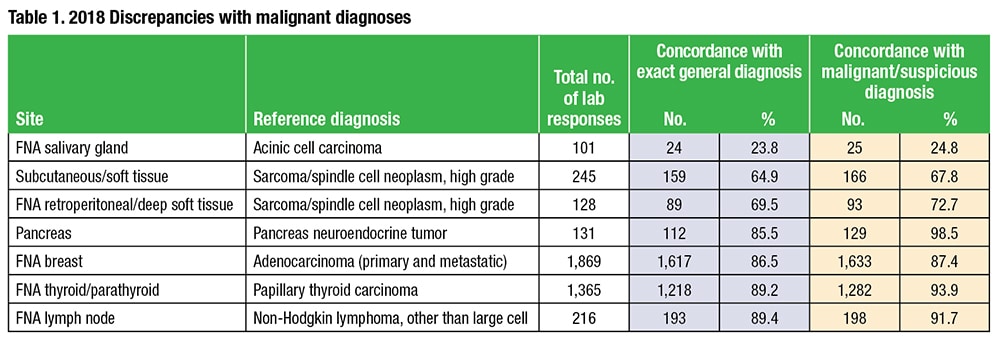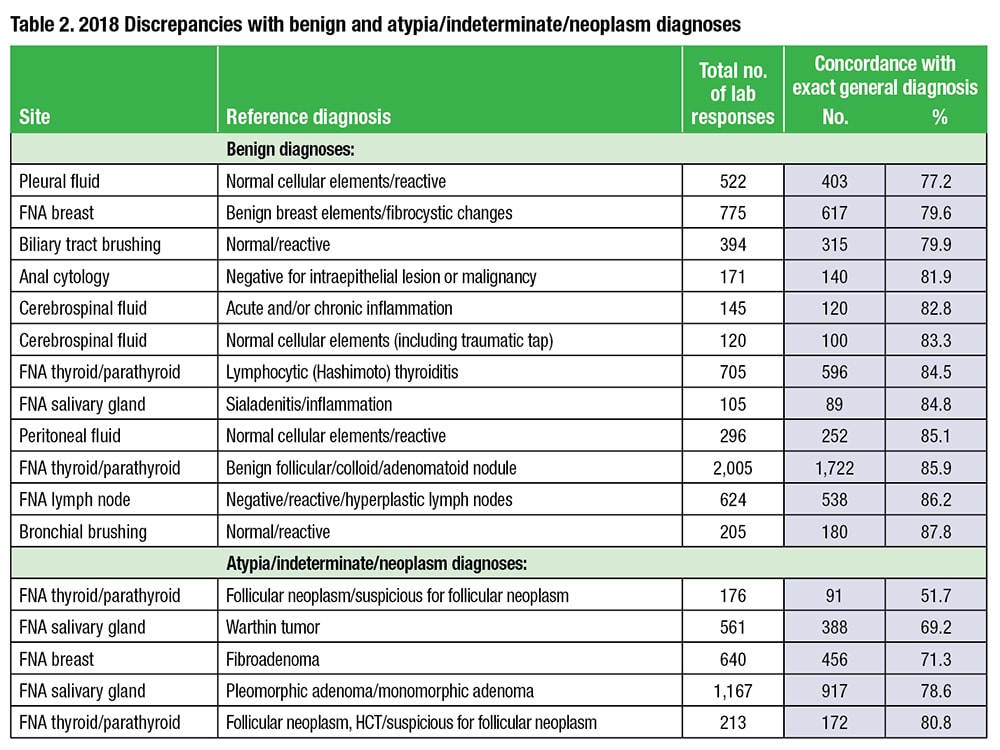To provide feedback on slide performance, statistics are generated for each diagnostic category as well as for each slide regardless of the number of responses. The previous four years’ worth of data were reviewed and certain trends were identified. Problematic areas—that is, those that show less than 90 percent participant agreement with the correct general diagnostic category—have been relatively consistent over the past four years. Discrepancies are due to under-calling of malignant cases as well as over-calling of benign and indeterminate cases. Data from the program from 2018 are in Tables 1 and 2. Only those cases with greater than 100 laboratory responses are included in the tables.

FNA case responses are more often discrepant with the reference diagnosis than other nongynecologic specimen types. Metastases and uncommon primary tumors are also disproportionately misclassified. This may be related to difficulties accessing or interpreting electronically available ancillary studies. Cases from certain organ systems, such as thyroid, breast, lymph node, salivary gland, and soft tissue, have historically been the most problematic. As may be expected, aspirates from sites with indeterminate diagnostic categories (i.e. thyroid and salivary gland) tend to have higher discrepant rates, reflective of the interobserver variability that is well established in the cytopathology literature. The Cytopathology Committee is closely monitoring slide performance to assess the impact of new classification systems on discrepancy rates.
 Within the lymph node and soft tissue FNA categories, aspirates from lymphomas and spindle cell lesions, respectively, appear to be the most challenging. Such cases are generally few in number in daily practice and rely heavily on ancillary studies for correct diagnoses. The committee is now in the final phase of reclassifying all lymph node FNAs in the program. These cases will soon be returned to the program. The Cytopathology Committee will continue to monitor discrepant cases to determine if slides reclassified to incorporate updated diagnostic terminology and inclusion of ancillary studies perform better in the program.
Within the lymph node and soft tissue FNA categories, aspirates from lymphomas and spindle cell lesions, respectively, appear to be the most challenging. Such cases are generally few in number in daily practice and rely heavily on ancillary studies for correct diagnoses. The committee is now in the final phase of reclassifying all lymph node FNAs in the program. These cases will soon be returned to the program. The Cytopathology Committee will continue to monitor discrepant cases to determine if slides reclassified to incorporate updated diagnostic terminology and inclusion of ancillary studies perform better in the program.
Members of the Cytopathology Committee are committed to providing valuable education in cytopathology. The committee uses data generated from these slide programs to provide additional educational content in diagnostically challenging areas and works diligently to provide an up-to-date and worthwhile educational experience, reflective of the needs of today’s practice. We value and use participant feedback on the educational experience, including quality of slides and ancillary material, to further enhance the Interlaboratory Comparison Programs.
Dr. Brainard, vice chair of the CAP Cytopathology Committee, is vice chair of cytology operations, Cleveland Clinic. Dr. Li, a member of the committee, is an associate professor of pathology, Ohio State University Wexner Medical Center, Columbus.
 CAP TODAY Pathology/Laboratory Medicine/Laboratory Management
CAP TODAY Pathology/Laboratory Medicine/Laboratory Management
